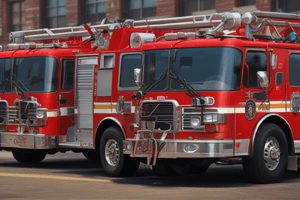Podcast
Questions and Answers
What is the responsibility of the Station Commander regarding atmospheric monitoring instruments?
What is the responsibility of the Station Commander regarding atmospheric monitoring instruments?
- To measure atmospheric concentrations of CO and HCN
- To calibrate and span the instruments monthly (correct)
- To use self-contained breathing apparatus in any atmosphere containing elevated levels of CO and HCN
- To record any significant exposures during a structure fire
Who is responsible for measuring atmospheric concentrations of CO and HCN at any location containing or suspected of containing elevated levels of CO?
Who is responsible for measuring atmospheric concentrations of CO and HCN at any location containing or suspected of containing elevated levels of CO?
- The Station Commander
- The Incident Commander or authorized designee (correct)
- All members
- The reporting officer
At what concentration of CO and HCN should all members use self-contained breathing apparatus (SCBA)?
At what concentration of CO and HCN should all members use self-contained breathing apparatus (SCBA)?
- 35 parts per million or greater of CO and 4.5 parts per million or greater of HCN (correct)
- 50 parts per million or greater of CO and 6 parts per million or greater of HCN
- 25 parts per million or greater of CO and 3 parts per million or greater of HCN
- 40 parts per million or greater of CO and 5 parts per million or greater of HCN
What can be used to reduce the CO concentration in the atmosphere?
What can be used to reduce the CO concentration in the atmosphere?
What should be done if skin becomes contaminated with hydrogen cyanide?
What should be done if skin becomes contaminated with hydrogen cyanide?
Who is responsible for recording any significant exposures during a structure fire?
Who is responsible for recording any significant exposures during a structure fire?
How often must the CO meter be calibrated?
How often must the CO meter be calibrated?
What is the purpose of the Atmospheric Monitoring for CO Policy?
What is the purpose of the Atmospheric Monitoring for CO Policy?
What is the responsibility of the Incident Commander or authorized designee?
What is the responsibility of the Incident Commander or authorized designee?
What is spanning of atmospheric monitoring instruments?
What is spanning of atmospheric monitoring instruments?
Flashcards are hidden until you start studying
Study Notes
- The policy establishes procedures for measuring atmospheric concentrations of carbon monoxide (CO) and hydrogen cyanide (HCN) at an incident for the safety of members working in potentially hazardous conditions.
- Calibration and spanning are defined, and it is the responsibility of the Station Commander to ensure that atmospheric monitoring instruments are spanned or calibrated to manufacturer’s specifications on a monthly basis.
- The Incident Commander or the authorized designee is responsible for measuring atmospheric concentrations of CO and HCN at any location containing or suspected of containing elevated levels of CO.
- All members shall use self-contained breathing apparatus (SCBA) in any atmosphere containing 35 parts per million or greater of CO and 4.5 parts per million or greater of HCN.
- Positive pressure ventilation may be used to reduce the CO concentration, as well as the presence of other toxic gases in the atmosphere.
- Gear worn, or people rescued from an active fire area may continue to off-gas HCN.
- Skin that becomes contaminated with hydrogen cyanide should be immediately washed or showered to remove the hydrogen cyanide.
- The reporting officer will be responsible for recording any significant exposures during a structure fire.
- Each time an atmospheric monitoring instrument is spanned or calibrated, the testing will be entered on a log.
- The CO meter must be calibrated once monthly and zeroed prior to each use.
Studying That Suits You
Use AI to generate personalized quizzes and flashcards to suit your learning preferences.




